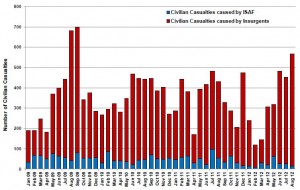Panetta, DoD Use Semantic Games to Claim Joint Operations Nearly Normal Again in Afghanistan

Civilian casualty rates in Afghanistan updated through August of 2012, as obtained by Spencer Ackerman at Danger Room. Click on image for a larger view.
Late Thursday, Leon Panetta contributed even further to his diminishing credibility by trying to claim that joint missions between US and Afghan troops are returning nearly to normal levels. From the Washington Post:
Most U.S. and NATO combat troops have resumed joint operations with Afghan forces, the Pentagon said Thursday, although U.S. officials said they remain worried about the threat of fratricidal “insider attacks.”
U.S. commanders had substantially scaled back the joint operations 10 days ago in an urgent effort to reduce the vulnerability of U.S. and NATO troops.
At a news conference, Defense Secretary Leon E. Panetta said “most” U.S. and NATO units had “returned to their normal partnered operations” with their Afghan allies. But he offered few details, and other Pentagon officials offered conflicting accounts of how many missions were still being conducted separately.
The new information was also found to be unclear by the New York Times:
In a significant restriction on a core element of the Western exit strategy from Afghanistan, the American-led military coalition said last week that all joint operations with Afghan forces conducted below the battalion level had to first go through a formal approval process — an effort to stem attacks by members of the Afghan security forces that have killed 51 American or allied service members this year. Officials now say those approvals were being handled efficiently enough that the number of partnered operations was returning to normal. . . . The number is now climbing again, said officials, who declined to offer specifics.
Spencer Ackerman is having none of this ploy, though, and the title of his piece from Thursday evening tells us all we need to know: “Whatever Pentagon Says, U.S. Patrols With Afghans Aren’t ‘Normal’ Yet“: Read more →
